About Plagioclase
Plagioclase – (series of minerals in the feldspar group), from Greek for oblique and fracture, in reference to the oblique angle between its best cleavages.
Anorthite (Ca%90-100 – Na%10-0) – from Greek for not straight, because of its triclinic symmetry.
Bytownite (Ca%70-90 – Na%30-10) – locality at Bytown (now the city of Ottawa), Canada.
Labradorite (Ca%50-70 – Na%50-30) – locality in Labrador; first brought from the Isle of Paul off Labrador in about 1770.
Andesine (Ca%30-50 – Na%70-50) – locality in the Andes Mountains, where it is the chief feldspar in the andesite lavas.
Oligoclase (Ca%10-30 – Na%90-70) – from Greek words meaning little and fracture, since it was belived to have less perfect cleavage than the related albite.
Albite (Ca%0-10 – Na%100-90) – from Latin albus (= white), in allusion to the color.
Feldspar (mineral group name), from Swedish names for field (feldt or falt) and spar (spat), in reference to the spar in tilled fields overlying granite; in German the word became Feldspat.
Anorthite (Ca%90-100 – Na%10-0) – from Greek for not straight, because of its triclinic symmetry.
Bytownite (Ca%70-90 – Na%30-10) – locality at Bytown (now the city of Ottawa), Canada.
Labradorite (Ca%50-70 – Na%50-30) – locality in Labrador; first brought from the Isle of Paul off Labrador in about 1770.
Andesine (Ca%30-50 – Na%70-50) – locality in the Andes Mountains, where it is the chief feldspar in the andesite lavas.
Oligoclase (Ca%10-30 – Na%90-70) – from Greek words meaning little and fracture, since it was belived to have less perfect cleavage than the related albite.
Albite (Ca%0-10 – Na%100-90) – from Latin albus (= white), in allusion to the color.
Feldspar (mineral group name), from Swedish names for field (feldt or falt) and spar (spat), in reference to the spar in tilled fields overlying granite; in German the word became Feldspat.
Plagioclase hand-specimen
Formula: NaAlSi3O8 – CaAl2Si2O8
System: Triclinic
Color: Colourless, reddish grey, white
Lustre: Vitreous
Hardness: 6–6½
Density: 2.6–2.76
System: Triclinic
Color: Colourless, reddish grey, white
Lustre: Vitreous
Hardness: 6–6½
Density: 2.6–2.76
Plagioclase PPL properties
Relief: Low-moderate negative/positive (Albite-Anorthite series)
Habit/Form: Plagioclase commonly occurs both as euhedral and anhedral grains. Crystals are usually tabular parallel to (010) and elongate parallel to the c or a axis. Cross sections are more or less rectangular.
Color: Colorless, frequently cloudy due to incipient alteration
Pleochroism: –
Cleavage: Sometimes after 1 or 2 directions; but are difficult to see in thin section due to very low relief; perfect on {001} and good/distinct on {010}, intersecting essentially at right angles.
Habit/Form: Plagioclase commonly occurs both as euhedral and anhedral grains. Crystals are usually tabular parallel to (010) and elongate parallel to the c or a axis. Cross sections are more or less rectangular.
Color: Colorless, frequently cloudy due to incipient alteration
Pleochroism: –
Cleavage: Sometimes after 1 or 2 directions; but are difficult to see in thin section due to very low relief; perfect on {001} and good/distinct on {010}, intersecting essentially at right angles.
Plagioclase XPL properties
Isotropy/Anisotropy: Anisotropic
Interference color: Order I gray to white; feldspars are very useful in determining the thickness of any slide in which it occurs.
Extinction angle: The extinction is inclined in almost all orientations.
Twins: Is often characterized by a distinctive polysynthetic twinning (it looks like jail bars |||| 🙂 ), and it’s called ‘Albite law’ or ‘chessboard’ albite; and contains alternating twin lamellae somewhat like the pattern of squares on a chessboard, except the units tend to be elongate and lath shaped rather than square.
Also, Albite-Anorthite series (plagioclase) is characterized by a distinctive zoned structure. This chemical zoning is common, particularly in volcanic and hypabyssal intrusive rocks, and is expressed as a variation in the extinction angle from one zone to another. The zoning is considered normal if it changes smoothly from a more calcic core to a more sodic rim. The core usually has a larger extinction angle. Reverse zoning is just the opposite. Oscillatory zoning shows alternation between calcic and sodic zones, but the overall trend is usually from a more calcic core to a more sodic rim.
The combination of polysynthetic twinning and zoned structure are very common.
Uniaxial/Biaxial: Biaxial (+/-)
Optic axial angle (2V): “Albite 2V measured: 45°, calculated: 76 – 82°
Anorthite 2V measured: 78 – 83°, calculated: 78°”
Interference color: Order I gray to white; feldspars are very useful in determining the thickness of any slide in which it occurs.
Extinction angle: The extinction is inclined in almost all orientations.
Twins: Is often characterized by a distinctive polysynthetic twinning (it looks like jail bars |||| 🙂 ), and it’s called ‘Albite law’ or ‘chessboard’ albite; and contains alternating twin lamellae somewhat like the pattern of squares on a chessboard, except the units tend to be elongate and lath shaped rather than square.
Also, Albite-Anorthite series (plagioclase) is characterized by a distinctive zoned structure. This chemical zoning is common, particularly in volcanic and hypabyssal intrusive rocks, and is expressed as a variation in the extinction angle from one zone to another. The zoning is considered normal if it changes smoothly from a more calcic core to a more sodic rim. The core usually has a larger extinction angle. Reverse zoning is just the opposite. Oscillatory zoning shows alternation between calcic and sodic zones, but the overall trend is usually from a more calcic core to a more sodic rim.
The combination of polysynthetic twinning and zoned structure are very common.
Uniaxial/Biaxial: Biaxial (+/-)
Optic axial angle (2V): “Albite 2V measured: 45°, calculated: 76 – 82°
Anorthite 2V measured: 78 – 83°, calculated: 78°”
Plagioclase distinguishing features under the microscope
Get Geology Toolkit Premium for more features of Plagioclase thin section under the microscope.
References
- Deer, W. A., Howie, R. A., & Zussman, J. (2013). An introduction to the rock-forming minerals (pp. 498). Mineralogical Society of Great Britain and Ireland, London.
- mindat.org – The Mineral Database




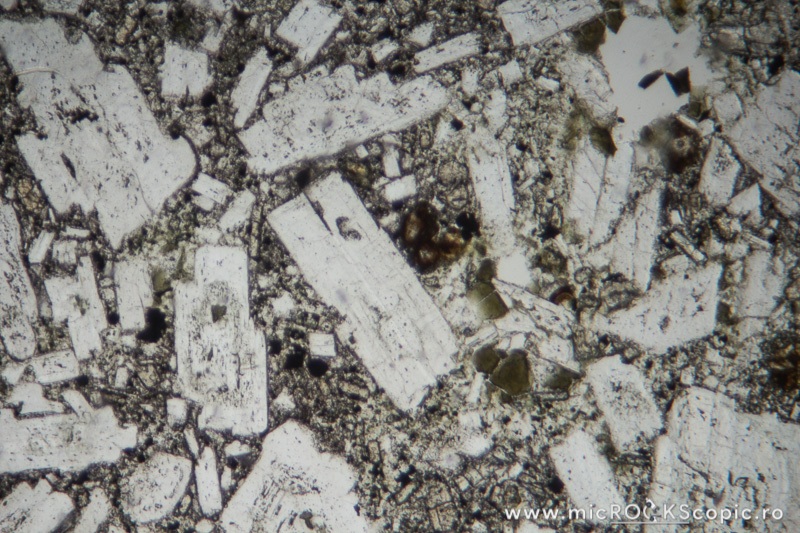



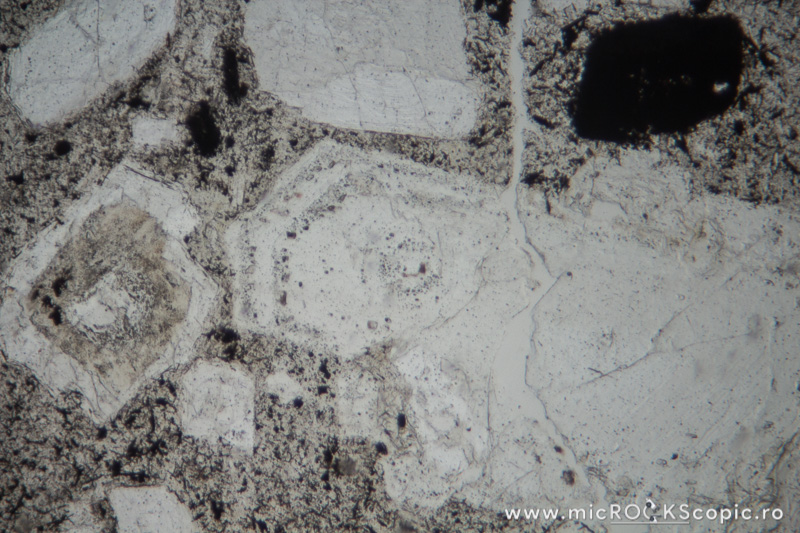


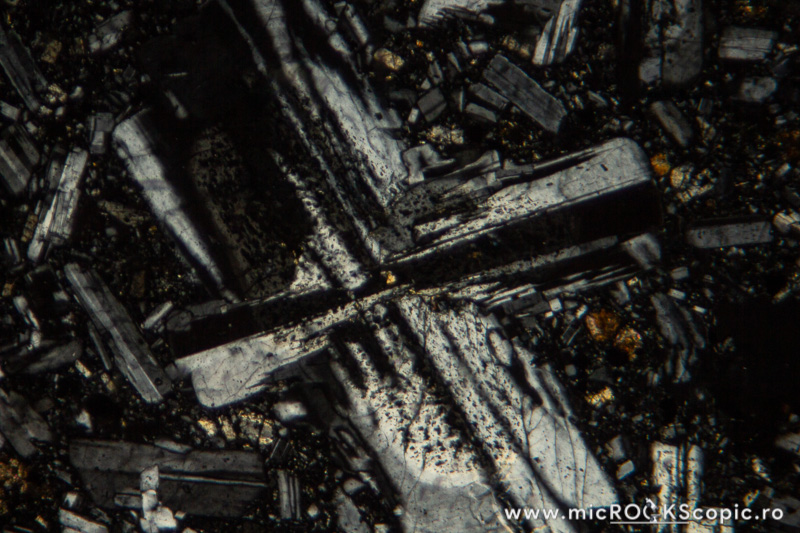










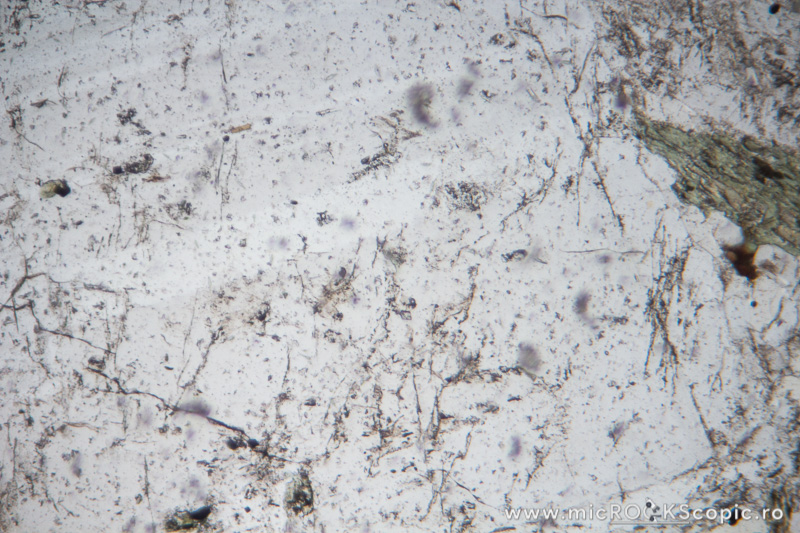

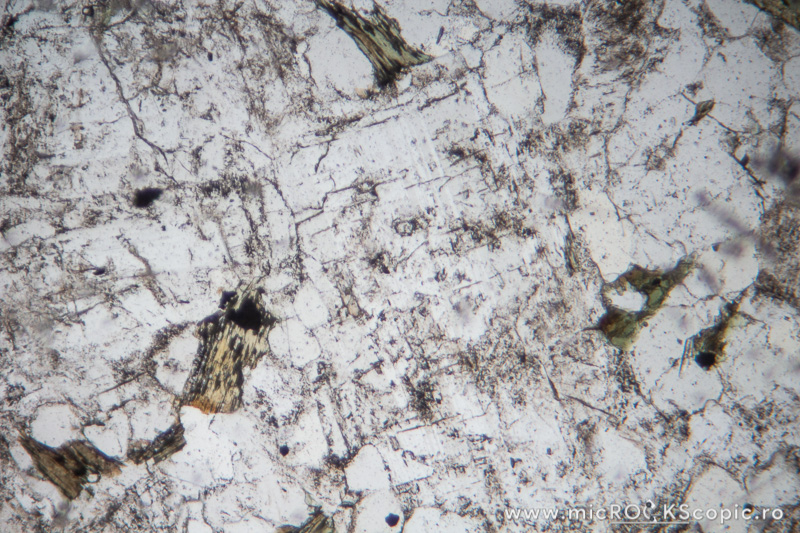
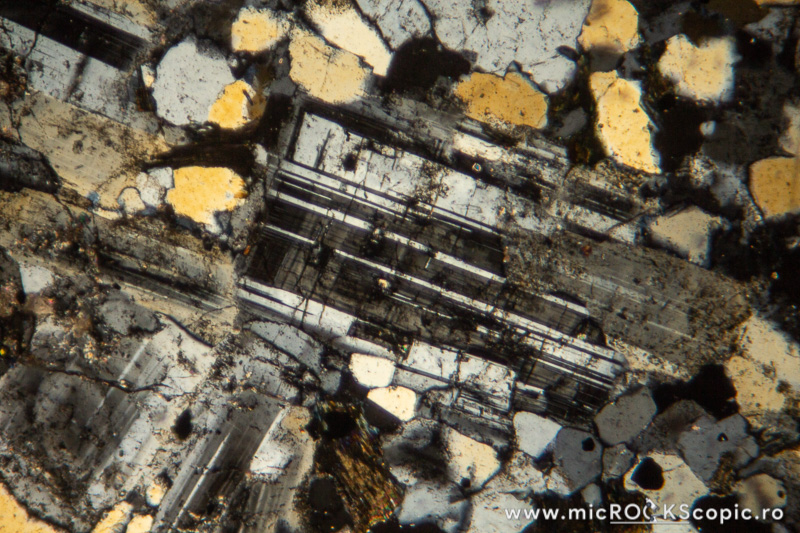

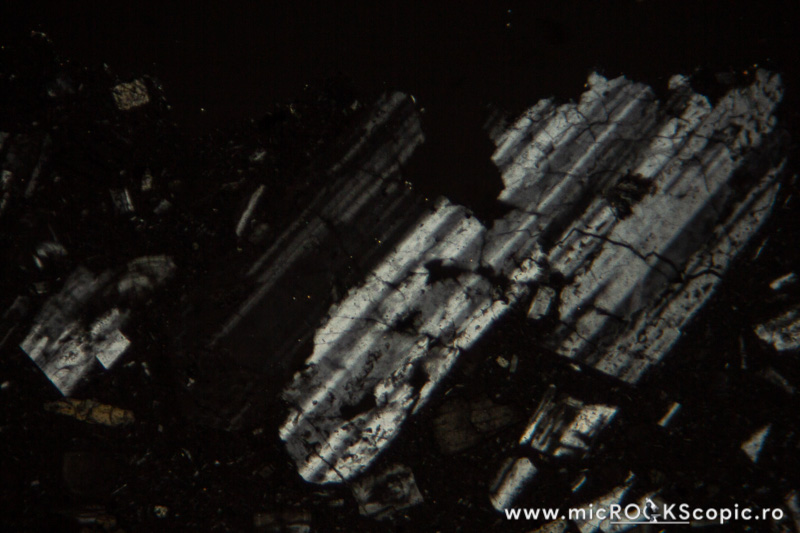

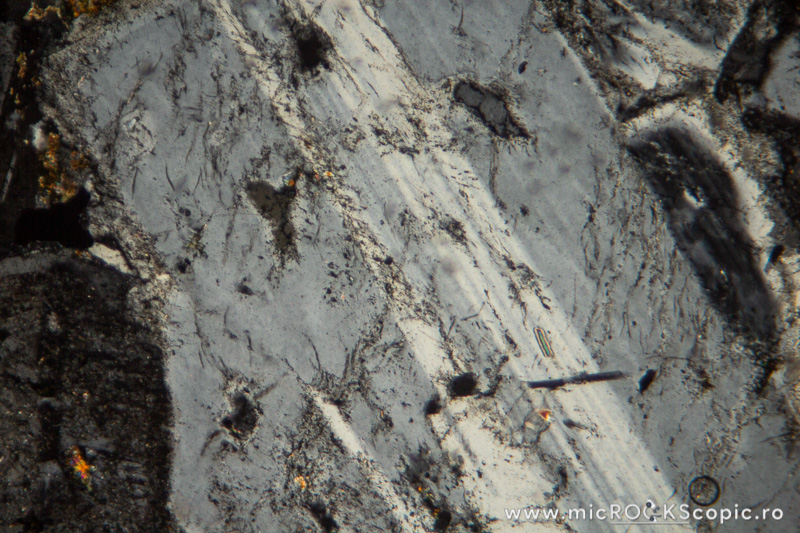
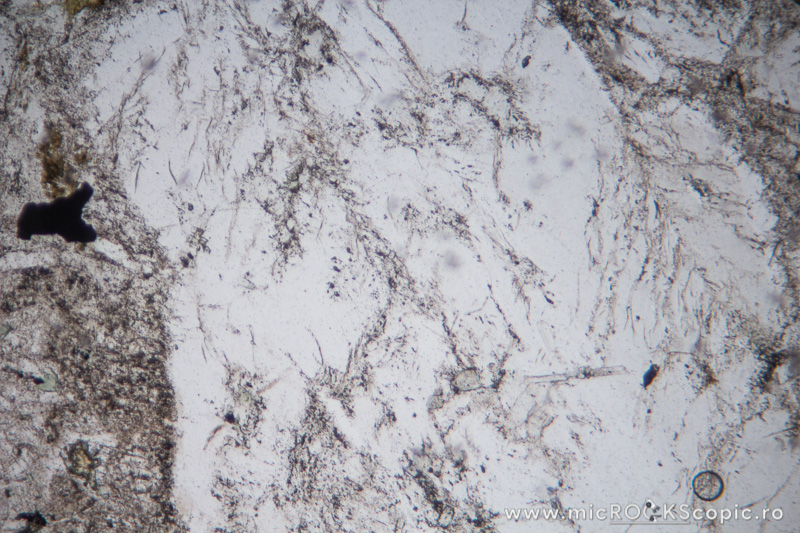
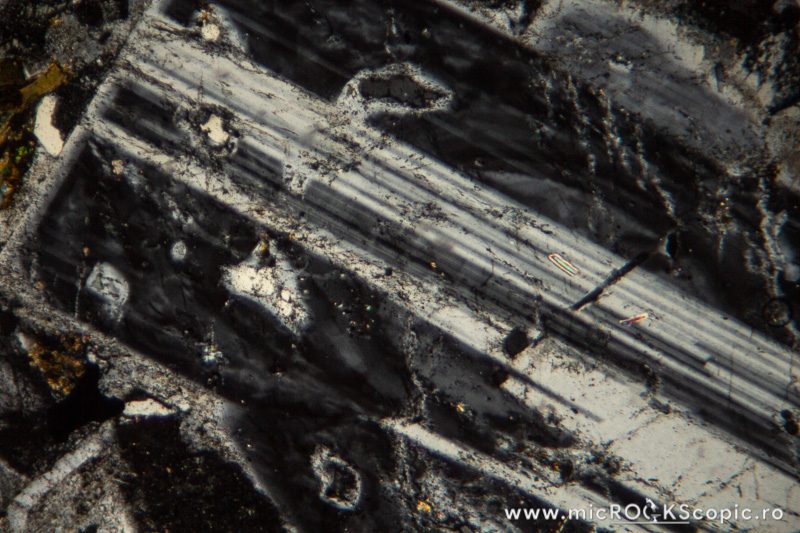
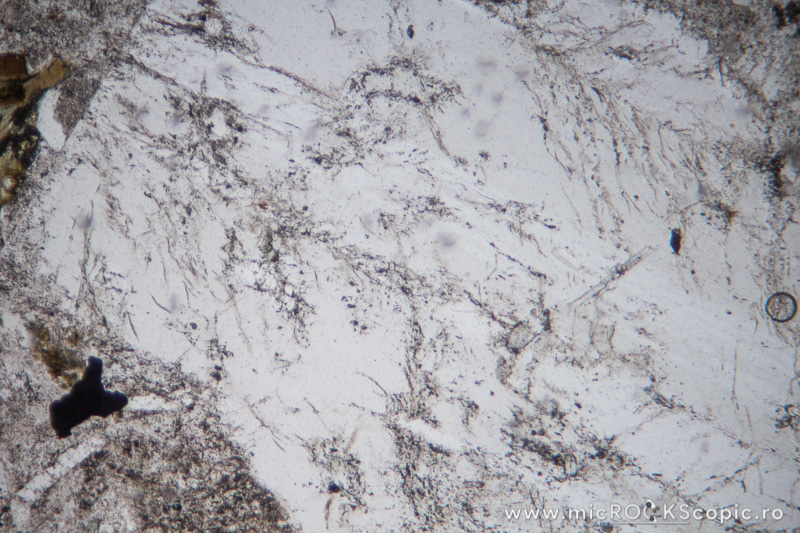

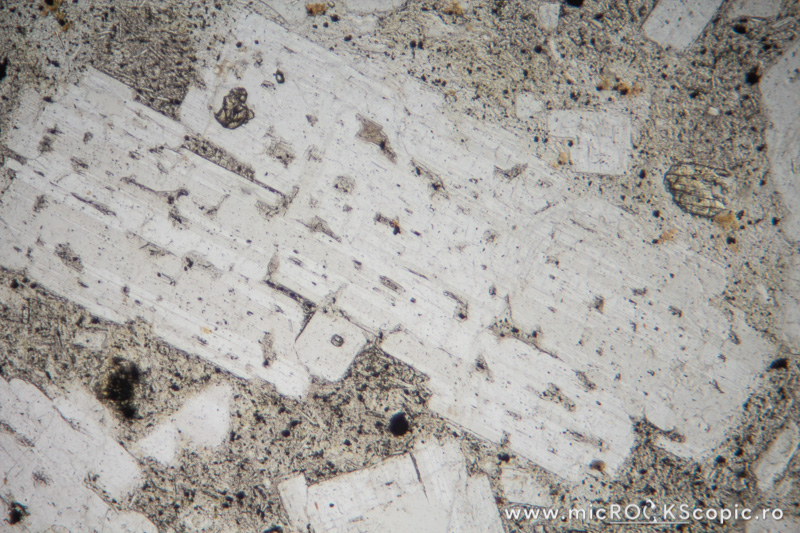


![[thumb]](http://microckscopic.ro/wp-content/uploads/plagioclase_2_11-150x150.jpg)
![[thumb]](http://microckscopic.ro/wp-content/uploads/plagioclase_17_poly_06-150x150.jpg)
![[thumb]](http://microckscopic.ro/wp-content/uploads/plagioclase_21_zonar_11-150x150.jpg)
![[thumb]](http://microckscopic.ro/wp-content/uploads/plagioclase_11_zonar_11-150x150.jpg)
![[thumb]](http://microckscopic.ro/wp-content/uploads/plagioclase_myrmekite_10-150x150.jpg)
![[thumb]](http://microckscopic.ro/wp-content/uploads/plagioclase_09-1-150x150.jpg)
![[thumb]](http://microckscopic.ro/wp-content/uploads/plagioclase_3_zonar_01-150x150.jpg)
![[thumb]](http://microckscopic.ro/wp-content/uploads/plagioclase_3_zonar_10-1-150x150.jpg)
![[thumb]](http://microckscopic.ro/wp-content/uploads/plagioclase_4_zonar_10-1-150x150.jpg)
![[thumb]](http://microckscopic.ro/wp-content/uploads/plagioclase_5_zonar_01-150x150.jpg)
![[thumb]](http://microckscopic.ro/wp-content/uploads/plagioclase_5_zonar_12-150x150.jpg)
![[thumb]](http://microckscopic.ro/wp-content/uploads/plagioclase_6_poly_01-150x150.jpg)
![[thumb]](http://microckscopic.ro/wp-content/uploads/plagioclase_6_poly_06-150x150.jpg)
![[thumb]](http://microckscopic.ro/wp-content/uploads/plagioclase_13_poly_12-1-150x150.jpg)
![[thumb]](http://microckscopic.ro/wp-content/uploads/plagioclase_14_poly_06-150x150.jpg)
![[thumb]](http://microckscopic.ro/wp-content/uploads/plagioclase_14_poly_09-150x150.jpg)
![[thumb]](http://microckscopic.ro/wp-content/uploads/plagioclase_18_poly_07-1-150x150.jpg)
![[thumb]](http://microckscopic.ro/wp-content/uploads/plagioclase_20_zonar_09-1-150x150.jpg)






